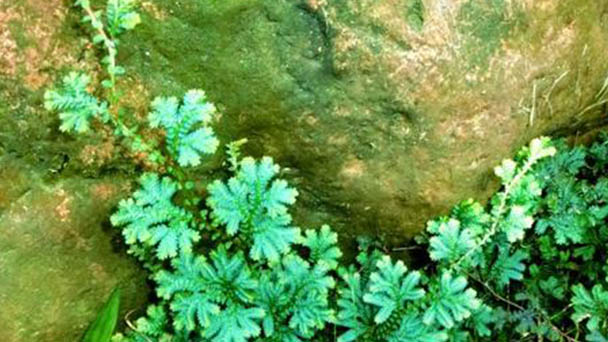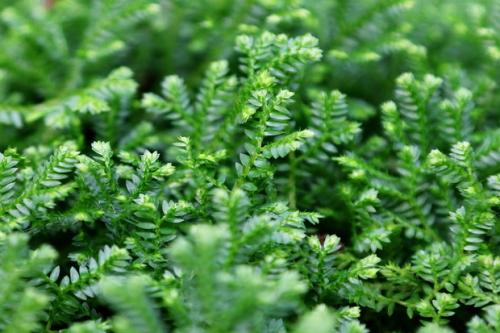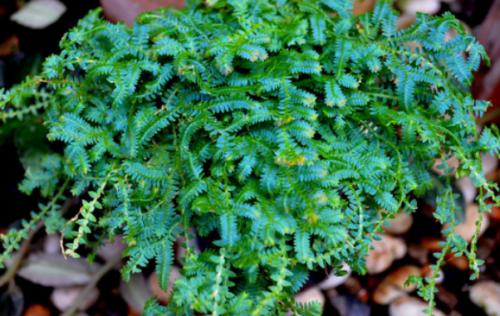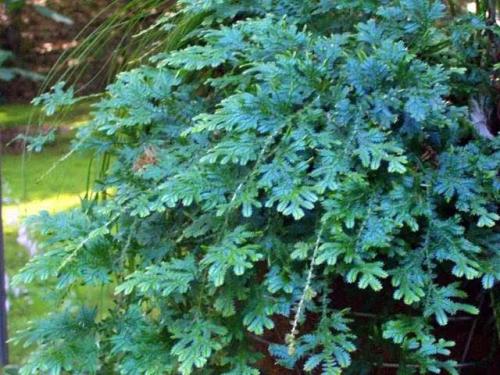Peacock moss profile
Written by Maggie
Jan 23 2021

Peacock moss, scientific name Selaginella uncinata, has a fine, sapphire sheen. It stands out. It adorns a desk, a table, and is lovely. Peacock moss is elegant and beautiful, is a small leaf plant, potted for desk, windowsill and other places.
Peacock Moss picture

Morphological features of Peacock Moss
Peacock moss (Selaginella uncinata) is a medium-sized overgrown fern. The main stem is overgrown, about 1m long, branching sparsely.Nodes have adventitious roots, leaves ovate, two rows sparsely. peacock moss has multiple forks. The vegetative leaves are two types, two rows of each dorsal ventricle, the ventral lobe is long ovate, the dorsal lobe is round, entire, spreading to both sides. Sporangium spikelet tetra-prismatic, spore leaves oval-shaped triangular, four rows imbricate.
Peacock moss' main stem is erect then climbing, 50-100 cm or longer, without transverse underground stems. Root support only on the lower part of the main stem or along the main stem spasmodically, growing below the independent stem bifurcation, 3 -- 10 cm long, 0.1 -- 0.5 mm in diameter, roots less bifurcated, hairy. Main stem of Peacock moss from the basal pinnate branch, not "the" font, no joints, straw color, 1-1.5 mm, lower part of main stem diameter cylindrical stem, grooved, glabrous, vascular bundle article 1, the top of the main stem not show dark brown, main stem apex whip, lateral branch of 5-8, 2 back to pinnate branch, branchlets arranged closely, adjacent branches 5-8 cm apart on main stem and branches glabrous, flattened back an abdomen, back to the branch at the end of the blade width 3.8 -- 6 mm.
Peacock moss (Selaginella uncinata) leaves are all cross-arranged, biform, herbaceous, smooth, iridescent, margin entire, distinctly white-edged, sparsely arranged, larger on main stem, biform, green.
Axils on main stem is clearly larger than on branches, reniform, or slightly cordate-shaped, 3 mm x 4 mm, symmetrical, broadly elliptic or cordate-shaped, 2.2 -- 2.8 mm x 0.8 -- 2.2 mm, margin entire, base not auricular, subcordate-shaped. Leaf blades are asymmetrical, those on main stem significantly larger than those on lateral branches, leaves ovoid, 1.0-2.4 mm x 0.6-1.0 mm, nearly imbricate, dorsal not keeled, apex parallel to axis or crossed or often curved backward, long acuminate, base obtuse, margin entire.
Peacock moss (Selaginella uncinata) lateral leaves are asymmetrical, much larger on main stem than on lateral branches, oblong on branches, abdominate, adnate, 2.2 -- 3.2 mm x 1.0 -- 1.6 mm, apex acute or mucronate, margin entire, upper base not enlarged, not covered with branchlets, upper margin entire, lower base rounded, lower margin entire.
Spore spikelets of Peacock moss (Selaginella uncinata) are compact, tetragonal, solitary at branchlet end, 5.0-25 mm x 2.5-4.0 mm; Leaf sporoforms, ovate-triangular, margin entire, with a white margin, apex acuminate, keel; The megaspore leaves are located on the lower side of the lower or the lower side of the middle or the lower side of the upper part of the spikelet. Megaspore grayish is white or dark brown; The microspores are pale yellow.
The Peacock moss (Selaginella uncinata) branch extends upward and is overlaid with alternate, pinnate, branchlets, last branchlets 4 -- 6 mm wide with leaves. Leaves are homomorphic, arranged flat, dark green below, blue above, ovate-elliptic, 2 -- 3 mm long, 1/2 -- 2/3 wide, apically sub mucronate, margin transparent, entire, proximally commensurate, base rounded or subcordate; Leaves largest on main stem, obliquely elliptic, sparsely grown, erect, margin transparent, all green, shortly acuminate to acute, base subcordate. Panicles of sporangia are tetragonal, 6-12.5 mm long; Spore leaves are dense, ascending, ovate-lanceolate, 2.5 mm long, with mid veins. Megaspore of Peacock moss (Selaginella uncinata) is yellow-white, the surface has irregular tubular warts; Microspore base has a crested hairy protruding, the middle has a number of rows of small spines. Cauline Voldemort vine, very fine soft, branching at the perennial adventitious roots, more branching. Peacock moss leaflets are ovate, sport leaflets ovate-triangular.
Habits of Peacock Moss
Peacock moss (Selaginella uncinata) likes warm, humid and semi-shady environments. The optimum temperature for growth is 20 ~ 26℃, and the temperature in winter is maintained above 5℃. Humus-rich, well-drained soil is required.
Peacock Moss is found in valley forests at an elevation of 40 ~ 1000m. It is also commonly found in valley forests or wet places near streams and in rock crevices. Many humus in the soil or the stream side damp weeds, and in the cave, wet rock or rock crevices.
Peacock Moss area
Peacock Moss (Selaginella uncinata) is mainly distributed in the central, southwestern and southern provinces of China, including Zhejiang, Fujian, Taiwan, Guangdong Hamirhaden, Guangxi, Hunan, Guizhou, Yunnan, Sichuan and other provinces and regions.
Peacock Moss is endemic to China and cultivated in other countries. The pattern specimens of Peacock Moss were collected from China.
Growing methods of Peacock Moss
Planting requirements
Moisture: Peacock moss (Selaginella uncinata) likes to be moist. Water is used regularly daily. Spray water with a water sprayer to keep the leaves moist and vigorous.
Fertilization: fertile sandy soil or humus soil.
Medium: Peacock Moss requires loose, fertile, well drained soil. It is better to use leaf mud.
Temperature: Peacock moss likes warm, grows well at about 20℃, overwintering temperature 5℃.
Light: Peacock moss likes half shade, summer attention, can not be insulated, otherwise the plant is easy to burn and die.
Daily maintenance
Sunlight: Peacock Moss is ideal for growing in a shaded, cool place, protected from the sun.
Management: Peacock moss (Selaginella uncinata) likes warm environment, resistance to humidity.
Water: Spray water and maintain high air humidity while Peacock moss is growing.
Peacock Moss prefers a warm, humid, semi-shaded environment. It is resistant to moisture. The pot soil should be loose and permeable and rich in humus. During the growing period of Peacock moss, attention should be paid to spraying water and maintaining high air humidity. The temperature in winter cannot be lower than 5℃, and the ideal temperature for growth is 10-15 ℃ at night and 21-26 ℃ during the day. Special attention should be paid to shading, strong light will make its blue-green disappear and affect the ornamental, growing season 1 times a month to apply liquid fertilizer.

Peacock Moss propagation methods
Peacock moss (Selaginella uncinata) is commonly propagated by branching and cuttings.
Division propagation method of Peacock moss
Dividing Peacock (Selaginella uncinata) moss is done in April or May at the time of potting. Dividing the densely growing bushes and placing them in a damp environment can be done. Cuttage can be in spring pruning, will cut the stem cutting directly in the sand bed, keep wet, about half a month to take root.
Disease control in Peacock Moss
Leaf spot
The leaf of Peacock moss (Selaginella uncinata) is initially black and round, then enlarged to be round or nearly round, with dark brown margin, grayish-black center and small black spot. After that, the leaf expands rapidly, and finally becomes black and dry and dies.
- 1. Diseased Peacock moss should be isolated and sprayed immediately, or cut off and burned centrally.
- 2. Use 50% carbendazim 1000 times solution, 50% methyl tobujin 1000 times solution, 200 times Bordeaux solution and other agents to spray control.
Peacock Moss main value
Landscape uses
Peacock Moss (Selaginella uncinata) is a small foliage plant with moire foliage and blue and green fluorescence. It is a potted plant suitable for display on desk or window sill.
Potted plants use
Peacock Moss (Selaginella uncinata) is a beautiful, blue-green fluorescent sight. It makes an excellent ground cover in the south, but also for northern potted ornamental use. It is best grown in patches in a trough and is an ideal mulch for orchid pots.
Ornamental value
Peacock Moss (Selaginella uncinata) is more suitable for family decoration, greening and beautification, and is suitable for ornamental potted plants in residential buildings. Larger potted Peacock moss, can be placed on shaded windowsills or balconies. Especially in the year between April and May, or in the early summer of the plum rain season, potted Peacock moss washed by light rain, like a beautiful woman's hair, waving.At this time, potted plant Peacock Moss is green and scaly. It is the best viewing period for Peacock Moss. It is very easy to appreciate.
Purify air
Peacock Moss (Selaginella uncinata) modulates indoor air, eliminates pollution, and refreshes the mind.

Latest Updated
- Benefits of Bugleweed - 7 Science-backed Health Benefits
- Bugleweed Dangers & Side Effects - Is It Poisonous?
- How to Plant Evergreen Trees - What You Should Know
- When to Plant Evergreens - Grow Guide for Evergreen Trees
- 12 Wonderful Evergreen Shrubs for Your Garden
- 12 Popular Evergreen Plants with Pictures for Beginners
- When And How To Prune A Lilac Bush Like a Pro
- How to Grow & Care for Lilac Vine (Hardenbergia Violacea)
- Japanese Lilac Tree (Syringa Reticulata) Care & Propagation Guide
- Shumard Oak Pros and Cons - What to Know
Popular Articles
- Winter maintenance of Antirrhinum Majus
- How to Grow Terminalia Mantaly Tree
- How to Grow and Care for Crossostephium Chinense
- How to grow Antirrhinum Majus in spring
- Peristeria Elata (Dove Orchid) Profile: Info & Care Guide
- Underwatered Snake Plant (Sansevieria Trifasciata) - Signs And How To Fix
- How to Care for Brazilian Jasmine Plant (Mandevilla Sanderi)
- How to Grow & Care for Graptopetalum Purple Delight in Summer
- Rosa Chinensis (China Rose): Plant Growing & Care Tips
- How to Care for Baby Sun Rose (Aptenia Cordifolia)